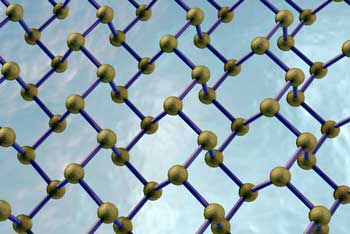| Feb 04, 2019 | |
Wrinkles take the heat(Nanowerk News) Single atomic sheets of black phosphorus are attracting attention for their potential in future electronics applications. A*STAR researchers have now completed experiments at the nanoscale to unlock the secret of this material’s remarkable directional heat transport properties (Advanced Materials, "Probing the physical origin of anisotropic thermal transport in black phosphorus nanoribbons"). |
|
| Black phosphorus has a layered honeycomb atomic structure that gives it some exotic physical and electronic properties. Its honeycomb lattice is not planar, but wrinkled, and its physical properties differ depending on whether they are measured across or along the wrinkles. Heat, for example, is transported about twice as fast in the wrinkle or ‘zigzag’ direction compared with across the wrinkles, or the ‘armchair’ direction. | |
 |
|
| Phosphorene is a 2D material consisting of a single layer of black phosphorus. (Image: ROBERT BROOK/SCIENCE PHOTO LIBRARY/Getty) | |
| Jing Wu and colleagues at the A*STAR Institute of Materials Research and Engineering used their state-of-the art experimental facilities to discover the reason for this very unusual status. | |
| “The strong anisotropy of heat transport in black phosphorus has been theoretically attributed to the dispersion or relaxation of lattice vibrations known as phonons, but the exact origin was unclear,” says Wu. “Understanding this mechanism could help us better control heat flow in nanoelectronic devices, which would be very useful in chip design for better heat dissipation.” | |
| The team started with the premise that the travelling velocity of phonons is equivalent to the speed of sound in a material, which in turn has a well-defined relationship to the material’s stiffness. They used their expertise in high-precision material measurements to set up an experiment that allowed them to measure both heat transport and stiffness in the same system, using black phosphorus nanoribbons with either a zigzag or armchair orientation. | |
| “Probing the heat transport and stiffness of the nanoribbons was very challenging,” says Wu. “We fabricated two orientations of nanoribbons by using electron-beam lithography on a thin film of black phosphorus. We then picked up the nanoribbons using nano-manipulators under a scanning electron microscope, and transferred them to our lab-built micro-electro-thermal system where they were tested using an atomic force microscope. These are techniques we have been developing and using for more than eight years.” | |
| These experimental measurements confirmed a physical link between the thermal transport and a measure of stiffness, known as the Young’s modulus, providing the first direct information on the origin of phonon transport anisotropy in black phosphorus. | |
| “The ratio of thermal conductivity between the zigzag and armchair nanoribbons is almost identical to the ratio of the corresponding Young’s modulus values,” says Wu, “and corresponds to the relationship theorized by first principles calculations.” |
| Source: A*STAR | |
|
Subscribe to a free copy of one of our daily Nanowerk Newsletter Email Digests with a compilation of all of the day's news. |
